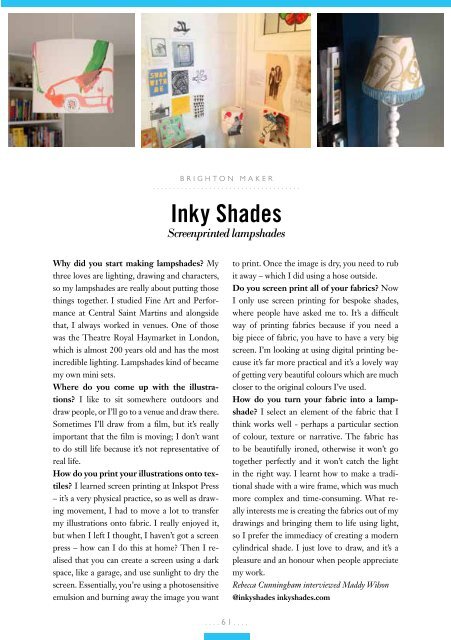Create successful ePaper yourself
Turn your PDF publications into a flip-book with our unique Google optimized e-Paper software.
ighton maker<br />
.....................................<br />
Inky Shades<br />
Screenprinted lampshades<br />
Why did you start making lampshades? My<br />
three loves are lighting, drawing and characters,<br />
so my lampshades are really about putting those<br />
things together. I studied Fine Art and Performance<br />
at Central Saint Martins and alongside<br />
that, I always worked in venues. One of those<br />
was the Theatre Royal Haymarket in London,<br />
which is almost 200 years old and has the most<br />
incredible lighting. Lampshades kind of became<br />
my own mini sets.<br />
Where do you come up with the illustrations?<br />
I like to sit somewhere outdoors and<br />
draw people, or I’ll go to a venue and draw there.<br />
Sometimes I’ll draw from a film, but it’s really<br />
important that the film is moving; I don’t want<br />
to do still life because it’s not representative of<br />
real life.<br />
How do you print your illustrations onto textiles?<br />
I learned screen printing at Inkspot Press<br />
– it’s a very physical practice, so as well as drawing<br />
movement, I had to move a lot to transfer<br />
my illustrations onto fabric. I really enjoyed it,<br />
but when I left I thought, I haven’t got a screen<br />
press – how can I do this at home? Then I realised<br />
that you can create a screen using a dark<br />
space, like a garage, and use sunlight to dry the<br />
screen. Essentially, you’re using a photosensitive<br />
emulsion and burning away the image you want<br />
to print. Once the image is dry, you need to rub<br />
it away – which I did using a hose outside.<br />
Do you screen print all of your fabrics? Now<br />
I only use screen printing for bespoke shades,<br />
where people have asked me to. It’s a difficult<br />
way of printing fabrics because if you need a<br />
big piece of fabric, you have to have a very big<br />
screen. I’m looking at using digital printing because<br />
it’s far more practical and it’s a lovely way<br />
of getting very beautiful colours which are much<br />
closer to the original colours I’ve used.<br />
How do you turn your fabric into a lampshade?<br />
I select an element of the fabric that I<br />
think works well - perhaps a particular section<br />
of colour, texture or narrative. The fabric has<br />
to be beautifully ironed, otherwise it won’t go<br />
together perfectly and it won’t catch the light<br />
in the right way. I learnt how to make a traditional<br />
shade with a wire frame, which was much<br />
more complex and time-consuming. What really<br />
interests me is creating the fabrics out of my<br />
drawings and bringing them to life using light,<br />
so I prefer the immediacy of creating a modern<br />
cylindrical shade. I just love to draw, and it’s a<br />
pleasure and an honour when people appreciate<br />
my work.<br />
Rebecca Cunningham interviewed Maddy Wilson<br />
@inkyshades inkyshades.com<br />
....61....


















